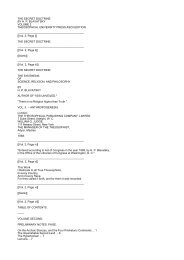Create successful ePaper yourself
Turn your PDF publications into a flip-book with our unique Google optimized e-Paper software.
Funeral Ceremonies.<br />
Sacred Texts Egypt Index Previous Next<br />
FUNERAL CEREMONIES.<br />
In illustration <strong>of</strong> <strong>the</strong> ceremonies which accompanied <strong>the</strong> burial <strong>of</strong> <strong>the</strong> dead <strong>the</strong> reader will find extracts<br />
from different texts printed in <strong>the</strong> Appendix on p. 264 ff. To <strong>the</strong>se may be added an extract from <strong>the</strong><br />
curious ritual which was in vogue in <strong>the</strong> Vth and VIth dynasties, and which commemorated <strong>the</strong><br />
ceremonies which were performed for <strong>the</strong> god Osiris. It is to be noticed how closely <strong>the</strong> deceased is<br />
identified with Osiris, <strong>the</strong> type <strong>of</strong> incorruptibility. Osiris takes upon himself "all that is hateful" in <strong>the</strong><br />
dead : that is, he adopts <strong>the</strong> burden <strong>of</strong> his sins; and <strong>the</strong> dead is purified by <strong>the</strong> typical sprinkling <strong>of</strong> water.<br />
While <strong>the</strong> gods are only accompanied by <strong>the</strong>ir ka's, <strong>the</strong> deceased, in right <strong>of</strong> his identification with a<br />
higher power, is accompanied by his Tet[1] also, that is, by his Osiris.<br />
Throughout <strong>the</strong> ceremony, <strong>the</strong> Eye <strong>of</strong> Horus,[2] which is represented by various substances, plays a<br />
prominent part, for it is that which gives vigour to <strong>the</strong> heart <strong>of</strong> <strong>the</strong> dead and leads him to <strong>the</strong> god. That<br />
portion <strong>of</strong> <strong>the</strong> ceremony which was believed to procure <strong>the</strong> unlocking <strong>of</strong> <strong>the</strong> jaws and <strong>the</strong> opening <strong>of</strong> <strong>the</strong><br />
mouth <strong>of</strong> <strong>the</strong> deceased, or <strong>of</strong> <strong>the</strong> statue which sometimes represented him, was performed after <strong>the</strong><br />
purification by water and incense had been effected; and hereby was he enabled to partake <strong>of</strong> <strong>the</strong> meat<br />
and drink <strong>of</strong>ferings, wherein <strong>the</strong> friends and relatives also participated, in order that <strong>the</strong>y might cement<br />
and seal <strong>the</strong>ir mystic unity with <strong>the</strong> dead and with <strong>the</strong> god with whom he was identified.[3]<br />
[1. Some fifty years ago, M. Reuvens expressed his belief that <strong>the</strong> ### represented <strong>the</strong> four quarters <strong>of</strong> <strong>the</strong> world, and<br />
according to M. Maspero it unites in itself <strong>the</strong> four pillars which support <strong>the</strong> sky and Osiris, whom <strong>the</strong>y preserve from<br />
chaos; see Recueil de Travaux, t. xii., p. 79, note 3; and Études de Mythologie, t. ii., p. 359.<br />
2. On <strong>the</strong> eyes <strong>of</strong> Horus, see Lefébure, Le My<strong>the</strong> Osirien--Les Yeux d'Horus, Paris, 1874; and Grébaut, Les deux yeux du<br />
Disque Solaire (Recueil de Travaux t. i., pp. 72, 87, 112-131).<br />
3. To discuss <strong>the</strong> origin and development <strong>of</strong> animal sacrifice among <strong>the</strong> early Egyptians lies outside <strong>the</strong> scope <strong>of</strong> this work.<br />
For information on <strong>the</strong> significance <strong>of</strong> sacrifice among <strong>the</strong> Semites, in whose customs many originally Egyptian ideas<br />
probably survived, see Robertson Smith, Religion <strong>of</strong> <strong>the</strong> Semites, p. 294 ff. On <strong>the</strong> origin <strong>of</strong> sacrificial acts, see Max<br />
Müller, Natural Religion, London, 1889, p. 184; and E. B. Tylor, Primitive Culture, vol. ii., p. 340. Whe<strong>the</strong>r <strong>the</strong> Egyptians<br />
regarded <strong>the</strong> sacrifice <strong>of</strong> bulls, geese, etc., at <strong>the</strong> tomb as expiatory <strong>of</strong>ferings, can hardly yet be decided.]<br />
{p. cxxxix}<br />
Certain formulae were directed to be repeated four times: a direction which takes us back to <strong>the</strong> time<br />
when <strong>the</strong> Egyptians first divided <strong>the</strong> world into four parts, each corresponding to one <strong>of</strong> <strong>the</strong> four pillars<br />
which held up <strong>the</strong> sky, that is to say, to one <strong>of</strong> <strong>the</strong> four cardinal points, East, South, West, and North,<br />
presided over by a special god. The deceased sought to obtain <strong>the</strong> assistance <strong>of</strong> each <strong>of</strong> <strong>the</strong> four gods <strong>of</strong><br />
<strong>the</strong> cardinal points, and to have <strong>the</strong> right to roam about in his district; hence <strong>the</strong> formula was repeated<br />
four times. Originally four animals or four geese were sacrificed, one to each god, but subsequently East<br />
and North, and West and South were paired, and two bulls (or birds) only were sacrificed, one <strong>of</strong> which<br />
was called <strong>the</strong> Bull <strong>of</strong> <strong>the</strong> North,[*] and <strong>the</strong> o<strong>the</strong>r <strong>the</strong> Bull <strong>of</strong> <strong>the</strong> South. The custom <strong>of</strong> four-fold<br />
repetition continued to <strong>the</strong> Ptolemaïc times[+] and even later.<br />
The priest whose <strong>of</strong>ficial title was kher heb, recited <strong>the</strong> prayers, and <strong>the</strong> sem or setem priest presented <strong>the</strong><br />
prescribed <strong>of</strong>ferings. The rubrical directions are given on <strong>the</strong> margin for <strong>the</strong> sake <strong>of</strong> clearness.<br />
http://www.sacred-texts.com/egy/ebod/ebod11.htm (1 <strong>of</strong> 5) [8/10/2001 11:24:10 AM]

















